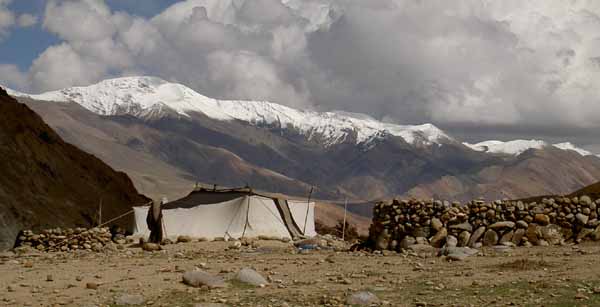|
Sani
This picturesque village
is 6 kms west of Padum, on the road to Kargil. The chief attraction here
is the castle like monastery which, unlike other monasteries of the region,
is built on level ground. By legend its initial foundation is associated
with Kanishka on account of the Kanika Stupa which stands in the backyard
of the walled complex. The main building comprises a huge multi-columned
central prayer hall housing an array of statues of popular Buddhists divinities
and Drugpa (Old Schools) high saints. The most interesting frescoes, however,
can be seen in a small, almost discarded chapel at the back of the main
building, whose walls are adorned with stucco murals depicting landscapes
and floral designs based on the life of Padma-sambhava. Adjoining this
monastic complex is an old cemetery surrounded by a ring of ancient rock
carving which reflect Indian artistic influence.
 Sani is also associated with
Naropa, the famous Indian yogi from Vikramsila, who is said to have sat
in meditation for some time under the Kanika Stupa. The site is now occupied
by a small room housing a veiled bronze figure of the Yogi, which is unveiled,
once a year in late July. A 2-day long festival is held to celebrate this
occasion, which is attended by people from far, and wide monks from Bardan
Monastery perform masked dances as ritual offering.
Sani is also associated with
Naropa, the famous Indian yogi from Vikramsila, who is said to have sat
in meditation for some time under the Kanika Stupa. The site is now occupied
by a small room housing a veiled bronze figure of the Yogi, which is unveiled,
once a year in late July. A 2-day long festival is held to celebrate this
occasion, which is attended by people from far, and wide monks from Bardan
Monastery perform masked dances as ritual offering.
How to Reach?
The 240 km long Kargil-Padun
road, of which the first 90 km stretch is paved, remains opened from around
mid July to early November. Jeeps and Gypsy taxis can also be hired at
Kargil. During June and early July, prior to opening of the road, it is
recommended to walk into Zanskar from panikhar or Parkachik onwards. In
June, the summer is at its height in the region and the climate is ideal
for trekking along the route free from vehicular traffic of any kind and
when the countryside is freshly rejuvenated into life after months of frigid
dormancy.
....Back
All
rights reserved. 
 |







